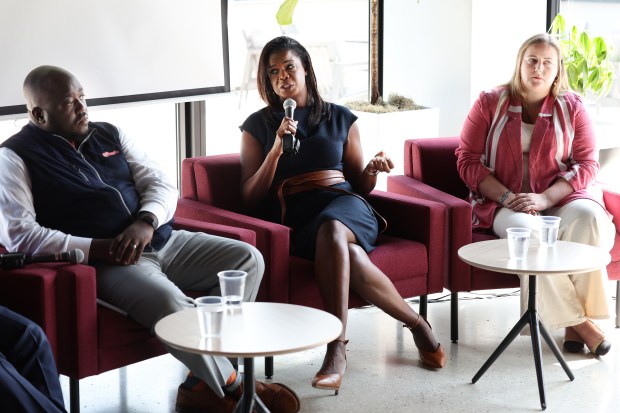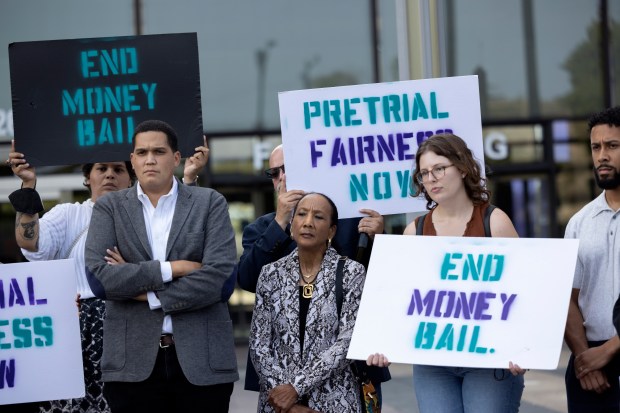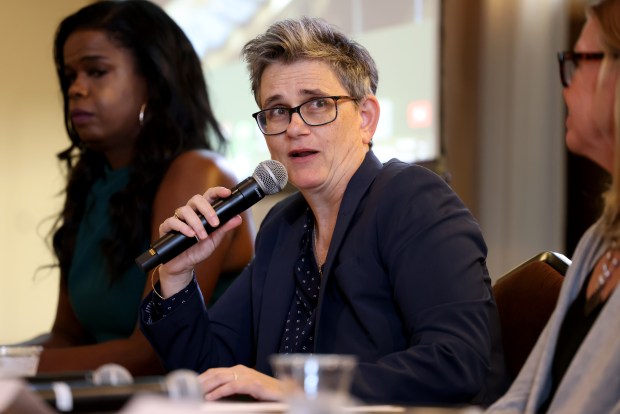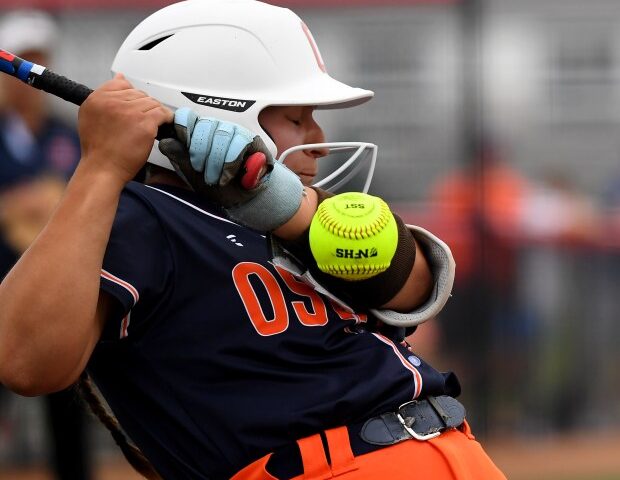During a recent public appearance, Cook County Public Defender Sharone Mitchell recalled the early days of working to pass, defend and then implement Illinois’ historic bail reform law amid intense furor.
“When I got a call from my aunt in North Carolina asking me if I was involved in a law that legalized murder, I knew it was crazy,” Mitchell said.
The state’s sweeping bail reform measure took effect nearly a year ago, eliminating money as a factor in whether a defendant is released from jail while awaiting trial and ushering in broad changes in how pretrial justice is handled.
Its passage and eventual implementation took an arduous path, with controversy over the law reaching a fever pitch and yielding misinformation campaigns as well as legal challenges.
“There was so much information, research, data, evidence proof but we were stuck on fake narratives about what was going to happen,” Cook County State’s Attorney Kim Foxx said at the same public summit about the Pretrial Fairness Act. “We don’t need 20 years to talk about what happened with the Pretrial Fairness Act. We don’t need 20 years to talk about the use of the term ‘purge’ … I just feel compelled in my time left in office to say truths that need to be spoken. It was racist. It was racist.”
Now that a year has passed since Illinois became the first state to legislatively outlaw bail, state and local officials are taking stock, hoping to leave the politics behind and evaluate the impact guided by data and other evidence.
With the caveat that studying such an impact can take years, researchers say the rate of defendants failing to appear in court has not increased. They point out — without giving it a causal link — that violent crime and property crime did not increase in the months after the law’s passage.
The impact on jail populations in Cook County and across the state has also been significant, with daily populations dropping in most places.
Officials have contended with a learning curve throughout the past year while implementing major changes in a massive and slow-to-change criminal justice system. Some particularly rural counties have contended with a shortage of resources to handle the changes. Appeals of detention decisions overwhelmed the appellate courts in the early days before the state’s high court made changes.
In Cook County, some attorneys and judges cited long court calls, and a need to examine how they are allocating staff and resources.
Even as counties continue to adjust, those who work in the system mostly say that the courts have settled into the new normal.
“We were given this big open highway called the PFA,” said Cook County Judge Mary Marubio, presiding judge of the pretrial division. “Slowly, we’re all finding where the lanes are and where the guardrails are.”
The politics of reform
In a 2022 political ad released by a group supporting then-Republican gubernatorial candidate Darren Bailey, big white letters set across scenes of violence proclaimed: “Chicago violence is coming to the suburbs.”
The year before, Gov. JB Pritzker signed into law the sweeping criminal justice reform legislation known as the SAFE-T Act, which included a measure that eliminated cash bail.
The reform bill, and particularly the bail provisions, was lauded by proponents as a vehicle for making the criminal justice system more fair and equitable, but the legislation spurred controversy, particularly taking a prominent role in the governor’s race between Bailey and Pritzker.
Some stakeholders raised concerns about the ability for judicial discretion, the public safety impact, resources and the implementation and logistics of making massive changes throughout the state.
But the ambitious reform, timed with a contentious election season, also became fodder for misinformation campaigns.
In fall 2022, political mailings designed to look like newspapers were sent to voters around the Chicagoland area. With titles such as the Will County Gazette, photos of mostly Black men were placed with false stories containing misinformation about the law.
“It’s a scare tactic. It’s meant to have people (show) concern for their safety. … It’s disgusting. It’s a terrible thing to do,” Pritzker said at the time.

Reflecting on the pushback, Mitchell said it was difficult to have policy debates, discussions and disagreements about the proposals amid the uproar.
“It was well-organized, well-funded and very intentional,” he said of the opposition.
On the policy side, officials designated a two-year ramp-up period to allow counties across the state time to prepare to train personnel, work through logistics and decide how to allocate resources. A task force convened by the Illinois Supreme Court led training and preparation efforts.
But on New Year’s Eve in 2022, one day before the Pretrial Fairness Act was set to take effect, the state’s high court delayed implementation to allow legal challenges from prosecutors across the state to be resolved.
The court order came after a Kankakee County judge sided with prosecutors in over 60 counties, mostly from downstate, who sued to stop the no-cash bail policy and other provisions of the act. The judge ruled, among other things, that the state legislature violated the separation of powers clause in the Illinois Constitution when it eliminated cash bail and interfered with the judiciary’s ability to set bail.
“How did we go from the most noble of goals to the most unconstitutional of outcomes?” Kankakee County State’s Attorney James Rowe argued in court in December 2022.
The Illinois Supreme Court ruled against the prosecutors in summer 2023, finding that the cash bail measure was constitutional.
Though the use of money bail has been eliminated or reduced in other jurisdictions, Illinois became the first state to fully outlaw it.
After a nine-month delay, the law took effect Sept. 18, 2023.
Initial findings
With a year in the rearview mirror, researchers are reviewing preliminary data throughout the state to try to answer big questions surrounding the law’s effectiveness and impact on public safety.
During a summit earlier this week, David Olson, co-director of Loyola University Chicago’s Center for Criminal Justice Research presented findings from approximately the first year, as part of a multiyear endeavor to examine the law.

The results will come into full focus over time, Olson said, and some metrics, particularly on whether a defendant released from jail committed any new crimes while awaiting pretrial, require longer periods of time for accurate findings.
Among the findings so far:
— Since the law took effect, defendants are spending significantly less time in jail while awaiting trial. The number of defendants detained for more than three days after the initial hearing decreased from 31% to 8% in 21 counties examined.
— In the first nine months following implementation, the elimination of cash bail resulted in $6.7 million in “avoided bond costs.”
— In 21 counties studied, warrants issued for failure to appear in court decreased slightly from 17% to 15%.
— Pretrial jail populations fell by about 14% in Cook County and other urban counties and more still in rural counties, about 25%.
— Concerns about overuse of electronic monitoring have not materialized at this point in time.
Olson also noted that violent and property crime decreased in the year after the Pretrial Fairness Act took effect when comparing January to June 2023 to the same time period in 2024, though he added that he’s not asserting any causal relationship.
“We’re not saying the Pretrial Fairness Act reduced crime and we’re also not saying the drop in crime might not have been larger had the law not been in effect,” he said. “But this is at least to put out there that crime has not gone up.”
Some stakeholders pointed out that fears of rampant increases in crime appear thus far unfounded.
“The sky did not fall,” Marubio said. “People are coming to court and communities are keeping more money within the community which was a reason for the reform.”
How the law works
During a recent detention hearing at the Leighton Criminal Court Building on the city’s Southwest Side, an assistant state’s attorney described a “random crime of opportunity:” A nurse leaving a hospital one morning was forced into her vehicle by a masked man holding a knife and made to drive to ATMs to take out cash.
“This was a hard-working person, in this case an employee at this hospital,” Judge Antara Nath Rivera said as she ordered the man detained while awaiting trial. “The defendant poses a threat.”
This is an example, most stakeholders say, of what is generally happening — that the most dangerous offenders are being held in jail.
Here, in a nutshell, is what the law does:
Previously, judges usually had the option of detaining a defendant without the option of posting bail, or ordering a monetary bond the defendant would have to post in order to be released.
Now, prosecutors decide on which cases they will ask a judge to hold a defendant before trial, if the defendant is charged with a “detainable” offense. The law deems some offenses “non-detainable” meaning prosecutors don’t have the option of seeking detention.
The cases for which prosecutors seek detention go to a hearing, which the law designed to be more robust, allowing defense attorneys more of a chance to argue the merits of the case.
All other cases go to an initial appearance hearing, where judges will decide on conditions for release, such as electronic monitoring or other less restrictive conditions.
Proponents of the measure say that this system allows judges to make decisions based on risk to the community, rather than wealth.
“I think it’s a far more thoughtful process now than it was before,” Foxx said.

In Cook County, from September of 2023 through August, prosecutors filed detention petitions for about 26% of all felony cases and 2% of misdemeanor cases, according to data from the chief judge’s office. Judges in turn granted detention for about 60% of the total petitions.
“There was a fear on one side that everyone would be detained, and there was a fear on the other side that no one would be detained and the jail doors would open,” said Alison Shames, director of The Center for Effective Public Policy. “What we’re seeing is that people are exercising their discretion as they should be doing.”
Still, some prosecutors hope for more discretion in which types of cases for which they can seek detention.
“Judges have discretion in a lot of cases, but not all and I firmly believe that a judge is in the best position to make that decision on detention in each individual case,” DuPage County State’s Attorney Robert Berlin said, though adding that the law is strong on violent offenses.
Jim Glasgow, Will County state’s attorney, said his office is functioning “very well under the new law” though he hopes to work with lawmakers to allow prosecutors to bring detention petitions on some non-detainable offenses. Glasgow, who has been a harsh critic of the law, filed a lawsuit against Pritzker and other top Democrats contesting the measure in September 2022, though he now says most of his concerns have since been addressed.
“Public safety is not in jeopardy as long as the state’s attorney has sufficient funding and staff to comply with the criteria,” he said.
On the ground
In DuPage and Will counties, Berlin and Glasgow said their offices added to their headcount to be able to meet the criteria set by the law.
“We’ve hired, I want to say, an additional 15 attorneys and have the budget to hire more,” Berlin said, adding that the increase is in part due to expanded use of body cameras, which requires more evidence review.
As the year progressed, Berlin said, his office also made changes in how it approaches domestic violence cases, filing detention petitions on nearly every such case after a Villa Park man who was released on electronic monitoring after being charged with domestic battery later killed a woman and then himself in April.
“Every domestic battery is a ticking time bomb,” Berlin said. “We made a number of changes after (Villa Park).”
The county has set up a system for domestic violence intake in which police officers call prosecutor felony screeners on misdemeanor domestic battery arrests, he said.
“I know we are doing a much better job of getting as much information as possible to the judge,” he said.
In Cook County throughout the past year, the massive undertaking played out in ways big and small. Judges and staff needed to supply courtrooms with new paperwork. The county reorganized court schedules, adding a new call for detention hearings and removing a former misdemeanor call.
In many ways, the hearings played out similarly to before, just with no mention of money as a factor for release. But court calls were often longer, sometimes straining resources.
“I definitely think that the court system now versus the court system a year ago is a little different. We are busier,” Marubio said, though she noted that September begins to mark the end of a typically busier summer season.
In preparing for the act, the county removed a court call for misdemeanors because most such cases would result in release from a police station with a summons. But more of those cases than anticipated have still made it through the courthouse doors because defendants who pick up a second misdemeanor will have to make an appearance.
“We’ve tried to be flexible and grow and adapt but on the front end I would say that was the biggest miscalculation,” she said.
They’ll examine how to pivot, whether it’s to reorganize court calls again, add more staff or other remedies.
“Big picture, we did it. We implemented, we adapted, it’s in effect. That piece is working,” Marubio said. “The nitty gritty of day-to-day court operations, we’re always tweaking.”





